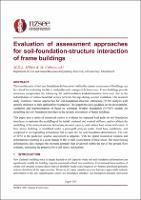Evaluation of assessment approaches for soil-foundation-structure interaction of frame buildings
Abstract
The consideration of soil and foundation deformations within the seismic assessment of buildings can be critical for evaluating the likely load paths and consequent deformations. Frame buildings provide numerous complexities for estimating the soil-foundation load-deformation behaviour, due to the redistribution of vertical load that occurs between footings during seismic excitation. Our research study examines various approaches for soil-foundation-structure interaction (SFSI) analysis with specific reference to their applicability to practice. This paper provides guidance on the development, validation and implementation of beam on nonlinear Winkler foundation (BNWF) models for modelling the soil-foundation interface in the seismic assessment of frame buildings.
This paper uses a series of numerical studies to evaluate the expected load paths on soil-foundation interfaces, to optimise the modelling of the initial rotational and vertical stiffness, and to validate the modelling of the moment-rotation behaviour, moment capacity and vertical load versus settlement. A four storey building is simulated under a push-pull analysis under fixed base conditions, and compared to corresponding simulations that account for the soil-foundation deformations. The role of SFSI in the push-pull seismic assessment is apparent, with the global foundation rotation and deformations resulting in a clear change in the overall development of base shear. The local footing deformations also changed the moment demands that developed within the top of the ground floor columns, increasing the potential for a soft storey mechanism.

